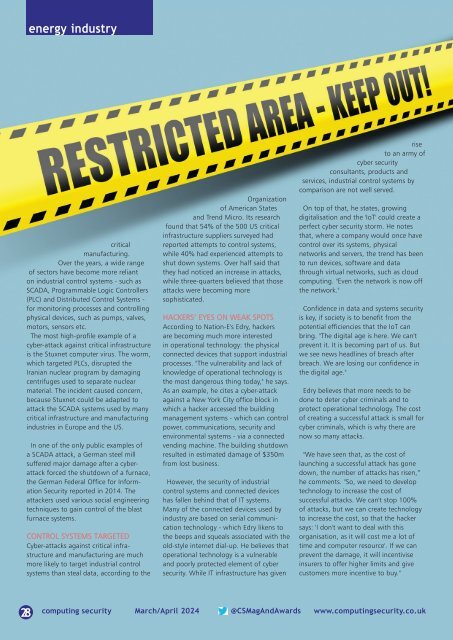CS Mar-Apr 2024
Create successful ePaper yourself
Turn your PDF publications into a flip-book with our unique Google optimized e-Paper software.
energy industry<br />
critical<br />
manufacturing.<br />
Over the years, a wide range<br />
of sectors have become more reliant<br />
on industrial control systems - such as<br />
SCADA, Programmable Logic Controllers<br />
(PLC) and Distributed Control Systems -<br />
for monitoring processes and controlling<br />
physical devices, such as pumps, valves,<br />
motors, sensors etc.<br />
The most high-profile example of a<br />
cyber-attack against critical infrastructure<br />
is the Stuxnet computer virus. The worm,<br />
which targeted PLCs, disrupted the<br />
Iranian nuclear program by damaging<br />
centrifuges used to separate nuclear<br />
material. The incident caused concern,<br />
because Stuxnet could be adapted to<br />
attack the SCADA systems used by many<br />
critical infrastructure and manufacturing<br />
industries in Europe and the US.<br />
In one of the only public examples of<br />
a SCADA attack, a German steel mill<br />
suffered major damage after a cyberattack<br />
forced the shutdown of a furnace,<br />
the German Federal Office for Information<br />
Security reported in 2014. The<br />
attackers used various social engineering<br />
techniques to gain control of the blast<br />
furnace systems.<br />
CONTROL SYSTEMS TARGETED<br />
Cyber-attacks against critical infrastructure<br />
and manufacturing are much<br />
more likely to target industrial control<br />
systems than steal data, according to the<br />
Organization<br />
of American States<br />
and Trend Micro. Its research<br />
found that 54% of the 500 US critical<br />
infrastructure suppliers surveyed had<br />
reported attempts to control systems,<br />
while 40% had experienced attempts to<br />
shut down systems. Over half said that<br />
they had noticed an increase in attacks,<br />
while three-quarters believed that those<br />
attacks were becoming more<br />
sophisticated.<br />
HACKERS’ EYES ON WEAK SPOTS<br />
According to Nation-E's Edry, hackers<br />
are becoming much more interested<br />
in operational technology: the physical<br />
connected devices that support industrial<br />
processes. "The vulnerability and lack of<br />
knowledge of operational technology is<br />
the most dangerous thing today," he says.<br />
As an example, he cites a cyber-attack<br />
against a New York City office block in<br />
which a hacker accessed the building<br />
management systems - which can control<br />
power, communications, security and<br />
environmental systems - via a connected<br />
vending machine. The building shutdown<br />
resulted in estimated damage of $350m<br />
from lost business.<br />
However, the security of industrial<br />
control systems and connected devices<br />
has fallen behind that of IT systems.<br />
Many of the connected devices used by<br />
industry are based on serial communication<br />
technology - which Edry likens to<br />
the beeps and squeals associated with the<br />
old-style internet dial-up. He believes that<br />
operational technology is a vulnerable<br />
and poorly protected element of cyber<br />
security. While IT infrastructure has given<br />
rise<br />
to an army of<br />
cyber security<br />
consultants, products and<br />
services, industrial control systems by<br />
comparison are not well served.<br />
On top of that, he states, growing<br />
digitalisation and the 'IoT' could create a<br />
perfect cyber security storm. He notes<br />
that, where a company would once have<br />
control over its systems, physical<br />
networks and servers, the trend has been<br />
to run devices, software and data<br />
through virtual networks, such as cloud<br />
computing. "Even the network is now off<br />
the network."<br />
Confidence in data and systems security<br />
is key, if society is to benefit from the<br />
potential efficiencies that the IoT can<br />
bring. "The digital age is here. We can't<br />
prevent it. It is becoming part of us. But<br />
we see news headlines of breach after<br />
breach. We are losing our confidence in<br />
the digital age."<br />
Edry believes that more needs to be<br />
done to deter cyber criminals and to<br />
protect operational technology. The cost<br />
of creating a successful attack is small for<br />
cyber criminals, which is why there are<br />
now so many attacks.<br />
"We have seen that, as the cost of<br />
launching a successful attack has gone<br />
down, the number of attacks has risen,”<br />
he comments. "So, we need to develop<br />
technology to increase the cost of<br />
successful attacks. We can't stop 100%<br />
of attacks, but we can create technology<br />
to increase the cost, so that the hacker<br />
says: 'I don't want to deal with this<br />
organisation, as it will cost me a lot of<br />
time and computer resource'. If we can<br />
prevent the damage, it will incentivise<br />
insurers to offer higher limits and give<br />
customers more incentive to buy."<br />
28<br />
computing security <strong>Mar</strong>ch/<strong>Apr</strong>il <strong>2024</strong> @<strong>CS</strong>MagAndAwards www.computingsecurity.co.uk
















